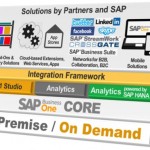If you are like many small businesses, the over-riding imperative is adding new customers and thats what your marketing activities are focused on.
Getting on the phone, sending a direct mail piece to your list, attending a trade show or running a webinar focused on finding customers who you think might have a need for your product or service is the immediate thing you probably think about doing – and you aren’t alone.
But then you execute the tactic you picked and then sit back after the activity is done and ask yourself, why did I do that, because it wasn’t the roaring success you had hoped for – and so you consign that activity to the mental folder entitled – “Stuff I tried that didn’t work”.
And you know what, sometimes here at SAP we are guilty of encouraging that behaviour – how?
We build campaigns and offer them to you as a partner and say, hey, you should try running this campaign because it has worked for other partners and maybe it will work for you. But the first question you should ask is , does this tactic fit in to my marketing strategy and if you find yourself saying, well, actually, we don’t have a marketing strategy, don’t panic – you are not alone.
So, the first step in building your marketing strategy is to determine who is your ideal customer – who are the kinds of customers that you would like to have more of, who get value from your services, pay their bills on time, refer other customers to you, don’t beat up your staff….I am sure you get the idea.
The key here is to avoid what a partner I used to work with at Microsoft used as their definition of an ideal customer – which was – “people who are ready to buy”. Now thats a good characteristic of an ideal customer but I guarantee that you’ll find it hard to build a campaign, buy a list or really target potential customers based on that definition.
So the questions you ask will guide you to a picture of who is your ideal customer and the point of the exercise is that you are looking for some key characteristics – the demographics or physical characteristics of your ideal customers and the psychographics of your ideal customer or factors such as – what problems they are trying to solve, how they buy, what they look for in a business partner, what they aren’t getting from their current solution and so on – and the good news is, hopefully, you can go through your existing customer base, identify the good customers and by determining how those customers match up against the key characteristics and where a pattern exists, you’ll be on your way to articulating your ideal customer.
Heres how one of our SAP Business One partners identifies their ideal customer –
Our ideal customer is a business with between 10 and 40 employees who are growing between 10 and 15% per annum. They are within a 40 km radius from our office and are in a wholesale or distribution industry. Ideally they sell products that require a maintenance contract and recognise that IT can assist them in growing their business. Typically they are currently on their 2nd accounting system, have a separate or no CRM application but they realise that automating the management of their customers is a critical need and are running a Microsoft based network.
Once you can articulate your ideal customer like this, you have taken your first step on the way to building a marketing strategy because you will now be able to articulate the kinds of customers you are looking for and the next steps will be easier – determining how do you find more of them, how do you get them to like you then trust,try and buy from you.
If you are an SAP Partner and you want to know more about how you can identify your ideal customers please dont hesitate to contact me via email and I would love to help you further.







Get Social